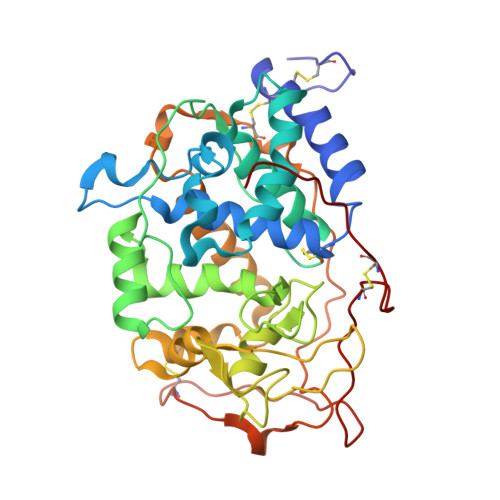High-Resolution Crystal Structure of Manganese Peroxidase: Substrate and Inhibitor Complexes.
Sundaramoorthy, M., Youngs, H.L., Gold, M.H., Poulos, T.L.(2005) Biochemistry 44: 6463-6470
- PubMed: 15850380
- DOI: https://doi.org/10.1021/bi047318e
- Primary Citation of Related Structures:
1YYD, 1YYG, 1YZP, 1YZR - PubMed Abstract:
Manganese peroxidase (MnP) is an extracellular heme enzyme that catalyzes the peroxide-dependent oxidation of Mn(II) to Mn(III). The Mn(III) is released from the enzyme in complex with oxalate. One heme propionate and the side chains of Glu35, Glu39, and Asp179 were identified as Mn(II) ligands in the 2.0 A resolution crystal structure. The new 1.45 A crystal structure of MnP complexed with Mn(II) provides a more accurate view of the Mn-binding site. New features include possible partial protonation of Glu39 in the Mn-binding site and glycosylation at Ser336. This is also the first report of MnP-inhibitor complex structures. At the Mn-binding site, divalent Cd(II) exhibits octahedral, hexacoordinate ligation geometry similar to that of Mn(II). Cd(II) also binds to a putative second weak metal-binding site with tetrahedral geometry at the C-terminus of the protein. Unlike that for Mn(II) and Cd(II), coordination of trivalent Sm(III) at the Mn-binding site is octacoordinate. Sm(III) was removed from a MnP-Sm(III) crystal by soaking the crystal in oxalate and then reintroduced into the binding site. Thus, direct comparisons of Sm(III)-bound and metal-free structures were made using the same crystal. No ternary complex was observed upon incubation with oxalate. The reversible binding of Sm(III) may be a useful model for the reversible binding of Mn(III) to the enzyme, which is too unstable to allow similar examination.
Organizational Affiliation:
Division of Nephrology, Department of Medicine, Center for Matrix Biology, Vanderbilt University Medical Center, Nashville, Tennessee 37232-2372, USA. m.sundaramoorthy@ vanderbilt.edu





















